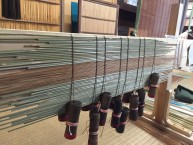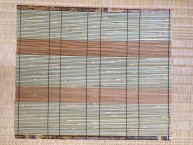I understood from the start that my new CIP experience would be largely different from my past one, as I would be engaging an entirely different slew of people. At the nursery, rather than being surrounded mostly by male senpai close to me in age, I am surrounded wholly by women whose ages I am too nervous to determine, who give off an air of adulthood, maternity, and warm indifference. This is different than the tight nervousness I’m accustomed to, in working with or being friends with people who are close to me in age, who seem to be more acutely aware of senpai-kouhai precariousness (when to speak politely, when to expect a foreigner to speak politely, when to be offended if not spoken to politely, how to determine how close a relationship is through the wall of keigo, etc.). In working at the nursery, all of the women treat me with kindness, speaking to me in varying levels of keigo, but all regarding me with mostly the polite dispositions of women who are secure in their seniority, and therefore lacking nervousness to which I had become accustomed.
When I first arrived at the nursery, I had set up a meeting with a teacher days previously, and I was waiting in the small play area outside of the classrooms. I was greeted for several minutes by a host of different teachers or assistants, who all seemed to be of various rank, encouraging me to wait a bit longer until the designated teacher could approach me. This was the first sense I had of a hierarchy within the nursery, as many of these other teachers and assistants seemed to defer to this more mature, casual teacher. When I met her, she spoke to me in keigo, and kindly, but it was predictably without the ‘deferent’ body language that I have come to expect in nervous first acquaintances or greetings exchanged between people whose ranks are unknown to each other, or, of course, in business situations (i.e. lots of bobbing head bows and wide smiles, accompanied with, usually in women, soft and placid voices).
Of course, this was a huge relief to me, in the sense that I immediately understood how to behave and also my basic irrelevance (a sense of irrelevance allows, for me, more freedom in observation, conversation, and general solicitation). This sense of hierarchy didn’t change over time, but did become more complex. For example, the teachers whom I mainly saw during my volunteer hours were some of the younger teachers. They were very casual with each other and spoke to me only rarely (though, not at all out of unkindness—there was more a sense of separate worlds in which we operated. Whenever I attempted to speak with one of them, I was mostly ushered towards the kids, as time together was limited). I seemed to be more in the way of a couple of these teachers at first, and I quickly realized that I should ask as few questions as possible in order to make their jobs as simple as possible.
At first, mostly teachers of a very young age, or women who looked and behaved somewhat like interns, only spoke to me, and usually in English, nervously about my schedule and what types of activities I wanted to do, trying to make me as comfortable as possible. They behaved similarly to me: quietly, relatively unobtrusively, standing in the back of student ranks while smiling in a vaguely dazed manner. But after the first couple of afternoons, I rarely saw those ladies again, I had no idea where they had gone.
This was in contrast to the more mature teachers, who frequently spoke to me and addressed me in the middle of class (much to my surprise), using much more high keigo than some of their younger staff members. This made me wonder how tenacious the use of keigo really was in hierarchical relationships. What did it mean that some teachers spoke to me in keigo, used the humble body language of keigo, and some did not speak to me in keigo at all, let alone with the physical aspect of highly polite speech? In some cases it seemed a case of age, but over time, I gradually began to feel as if the level of politeness actually indicated who thought that I was doing them a favor, and who thought that they were doing me a favor. With some teachers, I seemed to be treated more brusquely (althought not unkindly); I was understood to be a volunteer, but also justifiably someone who was kind of clumsy and likely to interrupt the working pace of the nursery. They seemed to understand that I was basically purposeless, and so left it up to me to make my experience valuable. With other teachers, I was much more gently regarded, as someone who was, perhaps, bestowing English powers upon the tiny ones, or otherwise regarded as someone who could sufficiently occupy them for a short period of time. Like a vaguely unintelligent playmate, which I was, for which one fosters great affection. In these times, keigo was used much more signficantly.
This, though perhaps simplistic in retrospect, seemed a big revelation after weeks of determining what exactly my role was at the nursery. But a “role” is something that mostly one determines for oneself, within certain boundaries. You have to consider the trouble you cause people in almost any position (except for, perhaps, English conversation circles, or others where you remain an esteemed guest). For me, passive observation was more crucial to my growth this semester, but last semester I had a completely different, more relationship-based CIP, and I felt completely different about each of those experiences. When starting a CIP, I think it is best to set vague goals about what you are expecting to “happen” or “receive.” There are a lot of factors, not just “Japanese culture,” positive attitudes, keigo, or one’s inability to assimilate, so nothing is wrong as long as one is actively learning, I think. I think it’s best not to feel the need to revolutionize your entire concept of Japanese culture through the CIP experience, or you will get skewed results, anthropologically and emotionally speaking.
Hopefully this experience at the nursery also allowed me to volunteer there with appropriate humbleness. I was, after all, encroaching upon the kindness of many women during the work day. I felt that I was able to learn significantly through my experience at the nursery, and I encountered various other questions and answers that I would like to explore more experientially throughout my remaining daily life in Japan. Even as I feel sure now that some of my spoken and unspoken assertions are correct within certain limited groups, or in groups composed of individuals with predictable temperaments, I cannot speak with any degree of confidence about the definite social nature of Japanese people. And that is for the best, I think. Still, the process has allowed me to, at the very least, become socially malleable, and that is an important first step in becoming a productive member of society no matter where I might go.


